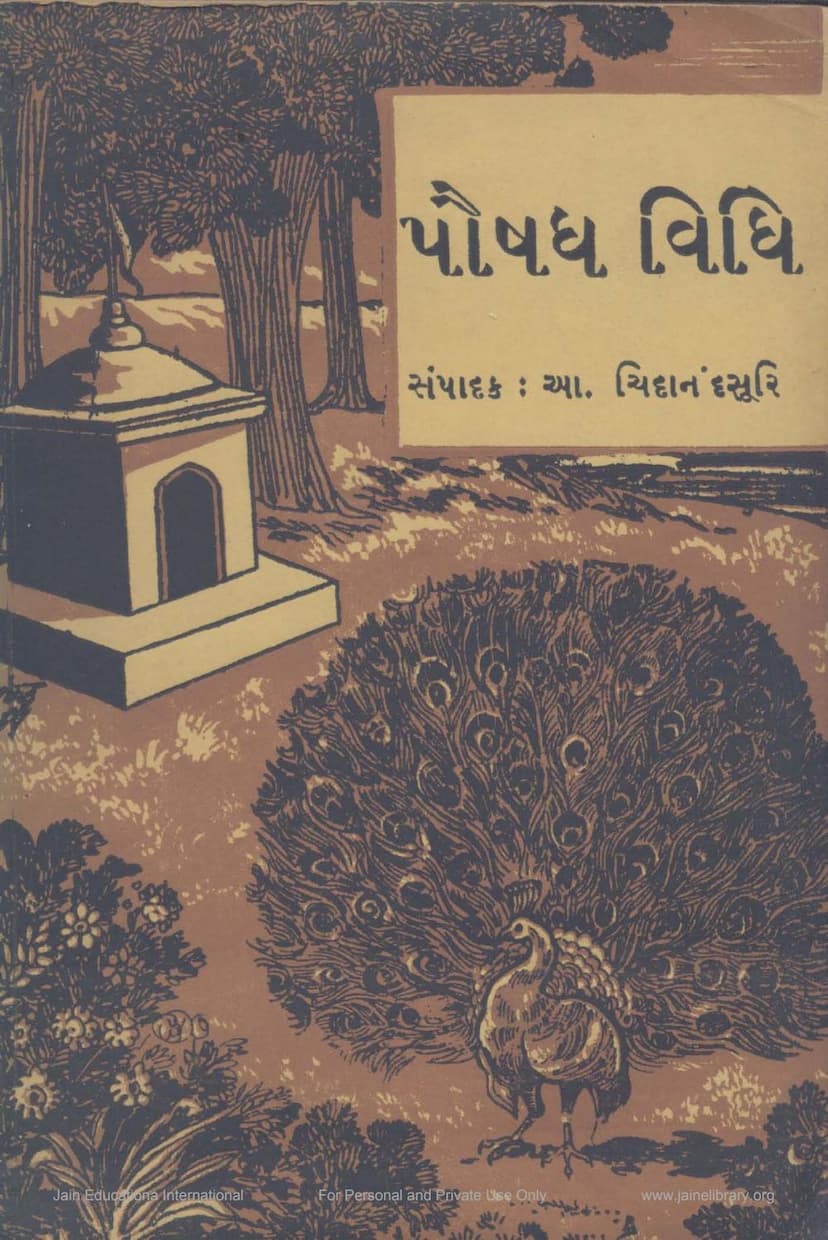Poshadh Vidhi
Added to library: September 2, 2025

Summary
This Jain text, titled "Poshadh Vidhi" (The Ritual of Poshadh), authored by Acharya Chidanandsuri and published by Nanpura Jain Sangh, provides a detailed guide to the practice of Poshadh, a significant vow for lay followers in Jainism.
The book is divided into several sections, each addressing a specific aspect of the Poshadh ritual and its associated practices.
Here's a comprehensive summary of its content:
Core Concepts of Poshadh:
- Definition: Poshadh is defined as an act that strengthens Dharma (righteousness or spiritual path). It is the eleventh of the twelve vows taken by a lay follower (Shravak).
- Types of Poshadh: The text outlines four main types of Poshadh:
- Aahar Poshadh: Abstaining from or controlling food intake (e.g., fasting, Ayambil).
- Sharir Satkar Poshadh: Renouncing bodily adornments and comforts (e.g., not bathing, not using perfumes or cosmetics).
- Brahmacharya Poshadh: Complete celibacy and abstinence from sensual pleasures.
- Avyapar Poshadh: Renouncing sinful or worldly activities and occupations.
- Categorization: These four types, when considered in terms of partial (desh) or complete (sarva) observance, lead to eight categories. Further nuances can create up to eighty variations. However, the text notes that currently, only Aahar Poshadh is commonly practiced in both partial and complete forms, while the other three are generally observed completely.
- Duration: Poshadh can be observed for a full day and night (eight prahars) or for half a day and night (four prahars).
- Pre-requisites: It is essential to perform Pratikraman (confession and atonement rituals) in the morning before observing Poshadh. The text clarifies the proper sequence: it is ideal to take the Poshadh vow first and then perform Pratikraman. However, exceptions and alternative sequences are also discussed based on tradition and practicalities.
Detailed Rituals and Practices:
The book provides step-by-step instructions for various actions performed during Poshadh, including:
- Taking the Poshadh Vow: The specific invocation and prayer to formally take the Poshadh vow.
- Performing Pratikraman: Detailed procedures for morning and evening Pratikraman.
- Dev Vandana (Worshipping Deities): Instructions on how to pay respects to the Tirthankaras and other divine beings.
- Reading Scriptures (Sajhayan): Guidance on reciting sacred Jain texts.
- Mukhapatti (Mouth Cloth) Rituals: Instructions on wearing and purifying the mukhapatti.
- Purification (Padilehan): Detailed methods for purifying various items like the mukhapatti, utensils, and clothing, emphasizing the use of specific "bols" (articulations or counts) for each item.
- Ayambil, Ekasanu, Nivi: Specific rituals related to these forms of fasting.
- Using Utensils and Water: Guidelines on the proper use of water (achitta - unboiled) and utensils, including the calculation of "chitt" (life-infusion) in water and its implications.
- Hygiene and Sanitation: Instructions for personal hygiene, including visiting the restroom (sthaldil) and proper disposal of waste.
- Entering and Exiting the Upashray (Monastery/Residence): Specific mantras and rituals for entering and leaving the dwelling place of ascetics or fellow practitioners.
- Mandal Vidhi: Performing mandalas (diagrams) as part of rituals.
- Santhara Parisidhi: Rituals associated with preparing a place for rest or meditation.
- Consequences of Errors: Mention of atonement (prayshchitta) for any mistakes or lapses during the ritual.
Explanations and Guidance:
- Essential Knowledge for Poshadh Observants: The text emphasizes the importance of understanding the meaning and details of the vow.
- Use of Items: Specific instructions are given regarding the type of materials to use (e.g., cotton clothes, woolen blankets).
- Pondering on Faults: The book lists 18 faults (dosha) to avoid during Poshadh and five principal transgressions (ativachar) that can invalidate the vow. It also lists 32 faults and 5 transgressions related to Samayik (equanimity practice), which is often performed alongside Poshadh.
- Specific Instructions: Detailed explanations are provided on various aspects like the timing for wearing a blanket, the duration for which water remains "achitta" (unaffected by life), and the correct way to handle consecrated items.
- Importance of Guru's Guidance: The text repeatedly stresses the need to seek guidance from a Guru for proper understanding and execution of these rituals.
Structure and Presentation:
The book is structured logically with an index (Anukramanika) guiding the reader through the various sections. It includes:
- Introduction: Explaining the significance of Poshadh.
- Detailed Ritual Steps: Each ritual is broken down into specific prayers, mantras, and actions.
- Explanations of Terms: Clarification of Jain terminology and concepts.
- Devotional Content: Includes prayers, stanzas, and verses for worship and reflection.
- Historical Context: Mentions of contributions from certain individuals and institutions in making the book available.
In essence, "Poshadh Vidhi" serves as a comprehensive manual for Jain followers who wish to observe the Poshadh vow with the correct understanding and adherence to the prescribed rituals, aiming for spiritual purification and merit.